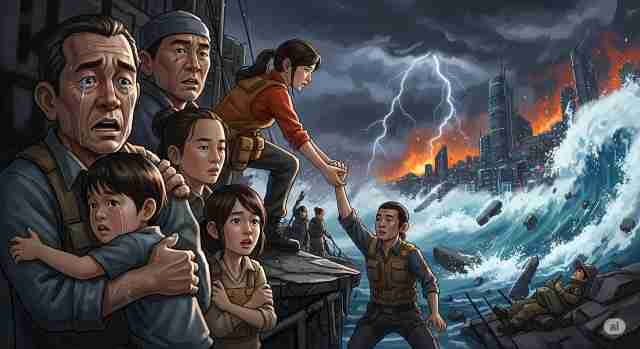Korean Disaster Movies: A Rising Global Phenomenon
Exploring the Appeal of Korean Disaster Films
Korean disaster movies have captured the imagination of audiences worldwide, emerging as a major trend among English-speaking film fans. These films stand out for their emotional depth, high production values, and the way they reflect contemporary societal anxieties. With new releases like *The Great Flood* and *Good News* generating buzz on streaming platforms and social media, now is the perfect time to explore this gripping genre.
Key Takeaways
- Emotional Storytelling: Korean disaster movies prioritize character development and emotional arcs, making the audience care deeply about the fate of the protagonists.
- Social Commentary: Many Korean disaster films address issues such as inequality, government response, and the fragility of modern life, encouraging viewers to reflect on real-world challenges.
- Moral Ambiguity: Rather than clear-cut heroes and villains, these movies often present complex characters whose decisions are shaped by desperation and ethical dilemmas.
Table of Contents
- Why Korean Disaster Movies Resonate Globally
- Trending Titles: New Korean Disaster Movies to Watch
- What Makes Korean Disaster Films Unique
- The Impact of Streaming and Social Media
- Actionable Strategies for New Viewers
- The Ongoing Evolution of the Genre
Why Korean Disaster Movies Resonate Globally
The international fascination with Korean disaster films began with the breakout success of *Train to Busan*, a film that combined pulse-pounding action with poignant social commentary. Since then, the genre has continued to evolve, offering stories that are both thrilling and deeply humane. What sets these films apart is their focus on ordinary people caught in extraordinary circumstances, the moral ambiguity of their choices, and the raw portrayal of human resilience in the face of catastrophe.
Unlike many Hollywood blockbusters, Korean disaster movies often delve into themes of community, survival, and the psychological toll of disaster. The characters are relatable, their struggles feel real, and the narratives often reflect broader societal issues such as urbanization, environmental crises, and collective trauma. This emotional resonance is a key reason why English-speaking audiences are increasingly seeking out recommendations and curated lists of Korean disaster films.
Trending Titles: New Korean Disaster Movies to Watch
The Great Flood (2025)
One of the most anticipated Korean disaster films of the year, *The Great Flood* is set for a global Netflix release in Q4 2025. Directed by Kim Byung Woo, this thriller stars Kim Da Mi, known for her roles in *Itaewon Class* and *Our Beloved Summer*, alongside Park Hae Soo from *Squid Game* and *Money Heist: Korea*.
Synopsis: A catastrophic flood engulfs the planet, leaving survivors—including AI researcher An Na and security team member Hee Jo—trapped in a sinking apartment building. As the water rises, Hee Jo’s urgent mission to save An Na raises questions: Why is he risking everything for her, and what secrets lie behind their connection? The film promises intense suspense, emotional stakes, and a fresh take on disaster survival.
With its high-profile cast and gripping premise, *The Great Flood* is already generating significant buzz. Early previews and social media trends indicate that this film will be a must-watch for fans of the genre, offering both edge-of-your-seat action and a thought-provoking exploration of human connection in times of crisis.
Good News (2025)
Another standout in the 2025 lineup is *Good News*, a disaster thriller inspired by the real-life hijacking of a Japanese passenger plane in 1970. Directed by Byun Sung-hyun and starring Sul Kyung-gu, Hong Kyung, and Ryu Seung-beom, the film will premiere at the Toronto International Film Festival before streaming globally on Netflix in October 2025.
Synopsis: Set against the backdrop of a tense international crisis, *Good News* follows a secret mission to safely resolve a hijacking. As the situation escalates, a mysterious figure known only as ‘Nobody’ is called in to orchestrate a daring rescue, while intelligence and military teams from Japan, South Korea, and the United States employ bold tactics to outmaneuver the hijackers.
The film’s blend of historical drama and disaster thriller elements, combined with its focus on teamwork and moral dilemmas, offers a compelling portrait of courage under pressure. *Good News* is poised to become a major talking point among fans of Korean cinema and disaster films alike.
What Makes Korean Disaster Films Unique
Korean disaster movies are more than just spectacles—they are cultural mirrors, reflecting the hopes, fears, and resilience of contemporary society. English-language reviewers and bloggers frequently highlight several distinguishing features:
- Emotional Storytelling: These films prioritize character development and emotional arcs, making the audience care deeply about the fate of the protagonists.
- Social Commentary: Many Korean disaster films address issues such as inequality, government response, and the fragility of modern life, encouraging viewers to reflect on real-world challenges.
- Moral Ambiguity: Rather than clear-cut heroes and villains, these movies often present complex characters whose decisions are shaped by desperation and ethical dilemmas.
- Focus on Ordinary People: The narratives typically center on everyday individuals, not action heroes, heightening the sense of empathy and realism.
This distinctive approach has fueled a vibrant recommend-and-review culture among English-speaking fans, who share plot synopses, emotional reactions, and character analyses across social media platforms and entertainment blogs.
The Impact of Streaming and Social Media
The rise of global streaming platforms like Netflix has played a pivotal role in the international popularity of Korean disaster movies. Major titles frequently chart in the Netflix Top 10 for non-English language films within days of release, while social media platforms see spikes in engagement around premieres. For instance, *The Great Flood* has already trended on TikTok and Twitter, with users sharing scene reactions and participating in hashtag challenges.
This level of engagement reflects not only the quality of the films but also the growing appetite for diverse storytelling among global audiences. Recommendation posts, listicles, and video essays about Korean disaster movies routinely attract high levels of interaction, indicating a sustained interest in discovering new titles and sharing personal favorites.
Actionable Strategies for New Viewers
For those new to Korean disaster movies or looking to deepen their appreciation, consider the following strategies:
- Start with Recent Hits: Begin with trending titles like *The Great Flood* and *Good News*, which offer a blend of suspense, emotion, and social relevance.
- Explore Curated Lists: Seek out curated recommendations from trusted entertainment blogs and YouTube creators, who often provide insightful synopses and critiques.
- Engage with the Community: Participate in online discussions and comment sections to share your thoughts and discover hidden gems recommended by other fans.
- Pay Attention to Themes: Notice how these films address broader societal issues, and reflect on how the stories resonate with your own experiences or concerns.
- Watch with Subtitles: To fully appreciate the performances and nuances of the original dialogue, opt for subtitles over dubbed versions whenever possible.
By following these strategies, viewers can gain a deeper understanding of the genre and join a global community of fans who value both entertainment and empathy in storytelling.
The Ongoing Evolution of the Genre
As Korean disaster movies continue to gain traction internationally, filmmakers are pushing the boundaries of the genre with innovative storytelling, cutting-edge special effects, and nuanced explorations of human nature. The upcoming releases of *The Great Flood* and *Good News* exemplify this evolution, offering fresh perspectives and compelling narratives that resonate across cultures.
The genre’s popularity shows no signs of slowing down, with new titles regularly featured in global streaming lineups and entertainment news. For English-speaking pop culture fans, Korean disaster movies represent an exciting frontier—one where gripping action, emotional depth, and cultural insight come together to create unforgettable cinematic experiences.
For more recommendations and in-depth analyses of Korean cinema, follow trusted entertainment blogs and stay tuned for the latest updates on upcoming releases. By exploring the world of Korean disaster movies, viewers can experience stories that not only thrill, but also inspire empathy and reflection—qualities that define the very best of global filmmaking.
Check out other related articles on Darakroom for more insights into the world of Korean entertainment.


